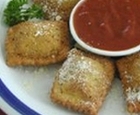|
Italian Appetizer Fried Ravioli So delicious! Use ravioli stuffed with meat, cheese, mushrooms...or anything. A warning—they're addictive.
Batter: combine eggs and milk in a bowl. In a separate bowl, mix breadcrumbs with grated cheese. Dip raviolis in egg-milk mixture, then coat with breadcrumb-cheese mixture. Set on a large plate and let rest for 30 minutes before frying. This helps batter to adhere. Frying: in a skillet, heat 4 T oil over medium heat. When oil is shimmering (not smoking), add raviolis, browning 3-4 minutes on each side. Remove and drain on paper towels. When ready to serve arrange on a platter around a bowl of warm dipping. Dipping Sauce: puree drained roasted peppers with 1 T oil in a food processor. Saute garlic in 1 T oil for 2 minutes (do not burn). Stir in pepper puree, tomatoes and remaining ingredients (except for parsley). Cook 10 minutes over low heat. Make a day or 2 in advance to allow flavors to meld. |
Tips & Glossary Arborio Rice: a medium-grained rice. Its high starch content yields a creamy texture and is the basis for risotto. Balsamic Vinegar: dark, thick vinegar with a sweet pungent flavor. Fermented, concentrated, and aged in wooden casks, sometimes up to 12 years. Can be pricey. Caper: salty, pickled bud of spiny shrub native to the Mediterranean region. Most prized is the non-pareil, the smallest (approx. 1/8”), though other sizes are tasty and less expensive. Formaggio: Cheese! Like France, Italy is a land of sublime cheeses, some 400 varieties. Here are some of the most widely sold in the U.S. Italian Seasoning: blend of dried herbs used in Italian cooking—marjoram, thyme, rosemary, savory, sage, oregano, and basil. Packaged commercially and found in most food stores. You can also make your own. Olive Oil: There's much more to know than is room for here. To learn all you need to know about the different grades of oil, and much, much more, head to Tanbourit. Pine Nuts: pinoli or pignoli; edible seeds of pine trees used in pesto sauce. Before cooking, release flavor by lightly browning in a heated skillet. Roasted peppers: buy or make your own: place under a broiler, or hold over a gas flame, till skin chars and blisters. Place in a closed paper bag for 15-20 minutes (to steam them). When cool, the skins slip off under water. Prosciutto: especially Prosciutto di Parma, dry-cured ham from Parma. The real deal! Cured up to 2 years, is almost sweet and very expensive. You can substitute with capicola, a delicious, light peppery ham.
|

